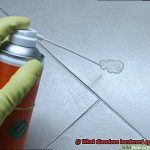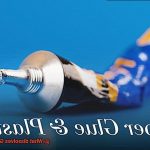Got a sticky situation with Gorilla Glue residue on your wooden surface? Don’t panic. There are several solutions that can dissolve this infamous adhesive without damaging the wood. Gorilla Glue is an industrial-grade adhesive that’s versatile and strong, making it perfect for woodwork projects and repairs. But when it comes to removing the glue, it’s not as easy as one might think.
Scraping or sanding the glue off may seem like a quick fix, but it can cause damage to the wood’s surface and ruin its natural characteristics. So, what dissolves Gorilla Glue from wood without harming the surface? In this blog post, we’ll explore some of the most effective methods to remove Gorilla Glue from wood without leaving any stains or marks behind.
We’ll cover everything from household items like vinegar and rubbing alcohol to specialized solvents from hardware stores. Plus, we’ll provide safety tips for working with chemical solvents. Whether you’re a novice DIY-er or an experienced carpenter, this guide will equip you with all the tools you need to tackle Gorilla Glue removal with ease.
Say goodbye to that pesky sticky residue and hello to a clean and flawless wooden surface.
What are the Dangers of Removing Gorilla Glue from Wood
Contents
- 1 What are the Dangers of Removing Gorilla Glue from Wood
- 2 How to Dissolve Gorilla Glue with Acetone
- 3 How to Dissolve Gorilla Glue with Rubbing Alcohol
- 4 How to Dissolve Gorilla Glue with Vinegar
- 5 Pros and Cons of Using Acetone, Rubbing Alcohol, and Vinegar
- 6 Tips for Removing Gorilla Glue from Wood
- 7 Alternatives to Solvents for Removing Gorilla Glue from Wood
- 8 Conclusion
When it comes to woodworking projects, Gorilla Glue is often the go-to adhesive for its exceptional strength. However, removing it from wood can be a risky and challenging task if not done properly. In this article, we will explore the potential dangers of removing Gorilla Glue from wood and offer some tips on how to do it safely.
Firstly, sharp tools are a common mistake people make when attempting to remove Gorilla Glue from wood. Using a knife or other sharp object to scrape away the glue can lead to dangerous accidents resulting in painful cuts or more severe injuries. Instead, opt for a plastic scraper or putty knife to gently pry the glue away from the wood.
Another potential danger is the use of chemicals to dissolve Gorilla Glue. While solvents like acetone, rubbing alcohol, or vinegar can break down the glue, they can also be hazardous if used improperly. For example, acetone is flammable and can cause skin irritation, while harsh chemicals like bleach or ammonia can damage the wood or even cause dangerous reactions if mixed together. Always wear proper protective gear and work in a well-ventilated area when using these solvents.
Aside from these risks, removing Gorilla Glue from wood can also be a time-consuming and challenging task. It may take several attempts to remove all traces of glue, so patience is key. Rushing the process or using excessive force can damage the wood or cause accidents.
Furthermore, it’s essential to note that different types of wood may react differently to glue removal techniques. Some woods may absorb solvents more readily than others, which could cause discoloration or other damage. Therefore, it’s always best to test a small area before applying any solvent to the entire surface.
How to Dissolve Gorilla Glue with Acetone
If you’ve ever used Gorilla Glue on a wood surface, you know how difficult it can be to remove once it dries. But fear not, as acetone is a powerful solvent that can dissolve Gorilla Glue from wood surfaces. As an expert on this topic, I will guide you through the process of dissolving Gorilla Glue with acetone.
Protect Yourself
First and foremost, it’s essential to protect yourself by wearing gloves and eye protection. Acetone is a potent solvent that can irritate the skin and eyes, so safety first.
Apply Acetone
Apply a small amount of acetone to a cotton swab or cloth and gently rub it onto the affected area. It’s important not to use too much acetone as it can damage the wood surface.
Wait Patiently
Give the acetone several minutes to dissolve the glue fully. Don’t rush this step, as it may take some time for the glue to soften.
Remove Glue Gently
Once the glue has softened enough, use a plastic scraper or putty knife to gently remove the glue from the wood surface. Be careful not to scratch or damage the wood surface.
Repeat if Necessary
If there are still remnants of Gorilla Glue left, apply more acetone and repeat the process until all of the Gorilla Glue has been dissolved and removed.
Clean Surface
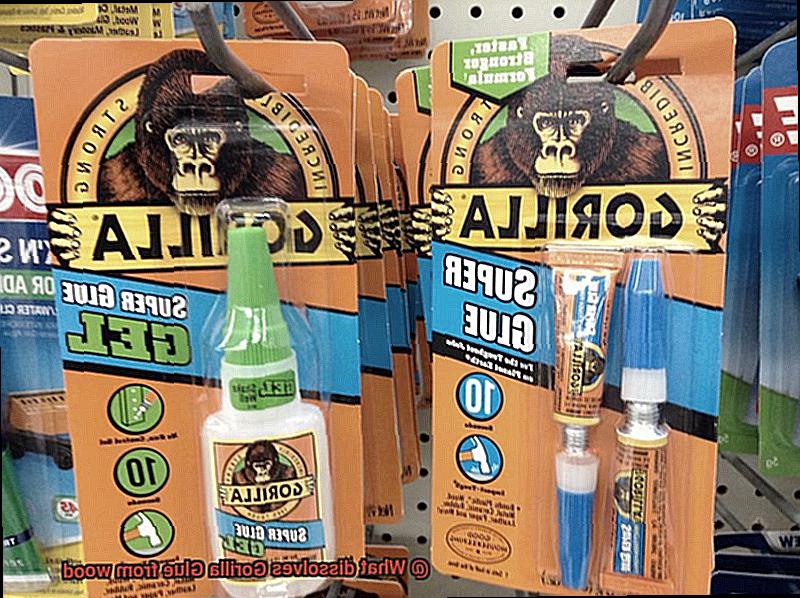
After removing the Gorilla Glue, clean the surface thoroughly with soap and water or sandpaper to smooth out any rough spots left by the glue.
It’s important to note that acetone is flammable and should be used in a well-ventilated area away from any open flames or heat sources. Additionally, acetone may dissolve some types of finishes and paints, so test a small area first before applying it to a larger area.
How to Dissolve Gorilla Glue with Rubbing Alcohol
Dissolving Gorilla Glue from wood surfaces can be a challenging task, but with rubbing alcohol, it becomes a breeze. Rubbing alcohol is an excellent solvent that can break down the adhesive’s chemical structure, making it easier to remove. Here are five sub-sections that provide a detailed explanation of how to use rubbing alcohol to dissolve Gorilla Glue from wood surfaces.
Gather Materials and Prepare
Before starting, gather all the necessary materials such as rubbing alcohol, cotton swabs or cloth, plastic scraper or putty knife, gloves, and a clean, damp cloth. Ensure that you work in a well-ventilated area and wear gloves to protect your skin from the harsh chemicals. It’s also essential to test the rubbing alcohol on a small, inconspicuous area of the wood surface before applying it to the entire surface.
Apply Rubbing Alcohol
Apply rubbing alcohol directly to the affected area using a cotton swab or cloth. Ensure that you apply the rubbing alcohol generously to cover the glue completely. The rubbing alcohol will soften the glue and make it easier to scrape away.
Allow It to Sit
Allow the rubbing alcohol to sit for a few minutes. This will give it enough time to break down the glue’s chemical structure, making it easier to scrape away. Be patient and wait for at least ten minutes before proceeding to the next step.
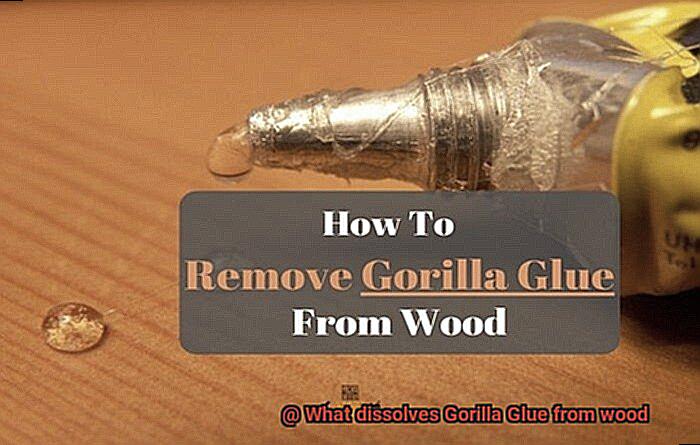
Scrape Away the Glue
Gently scrape off the dissolved glue with a plastic scraper or putty knife. Be careful not to damage the wood surface while scraping. If there is still glue residue on the wood surface, repeat the process by applying more rubbing alcohol and letting it sit for another ten minutes before scraping again.
Wipe Away Excess Rubbing Alcohol
Wipe away any excess rubbing alcohol with a clean, damp cloth after each application. Rubbing alcohol can dry out the wood surface if left on for too long, so it’s important to wipe away any excess promptly.
How to Dissolve Gorilla Glue with Vinegar
Gorilla Glue is a formidable adhesive that can be challenging to remove once it dries on wood surfaces. However, vinegar is an effective and popular solution for dissolving the glue. Vinegar contains acetic acid that breaks down the chemical bonds of the glue and weakens its grip on the surface. Here’s how to use vinegar to dissolve Gorilla Glue from wood:
Mix Vinegar Solution
Prepare a mixture of white vinegar and warm water in a 1:1 ratio. Mix the solution in a bowl.
Apply Solution
Using a clean cloth or sponge, apply the vinegar solution to the affected area. Let it sit for 15-20 minutes, allowing the solution to fully penetrate the glue.
Scrape Off Softened Glue
After the solution has had enough time to work, use a scraper or putty knife to gently remove the softened glue from the wood surface. Be cautious not to scratch or damage the wood.
Repeat If Necessary
If all of the glue has not been removed after one application, repeat the process until all of it is dissolved.
Other Considerations
It’s important to wear protective gear such as gloves and eyewear when handling vinegar or any other solvent to dissolve Gorilla Glue. Proper ventilation should also be ensured to avoid inhaling any fumes.
Vinegar may not work for all types of Gorilla Glue, especially if it has fully cured or if it is a large amount of glue. In such cases, other solvents may be necessary.
If the Gorilla Glue is particularly stubborn, you can try heating up the vinegar solution before applying it to the glue. Warm vinegar can be more effective at breaking down the adhesive properties of the glue.

Pros and Cons of Using Acetone, Rubbing Alcohol, and Vinegar
Fear not, for there are several solvents available to help dissolve this stubborn adhesive. However, before diving in, it’s important to weigh the pros and cons of each solvent. Let’s take a closer look at Acetone, Rubbing Alcohol, and Vinegar.
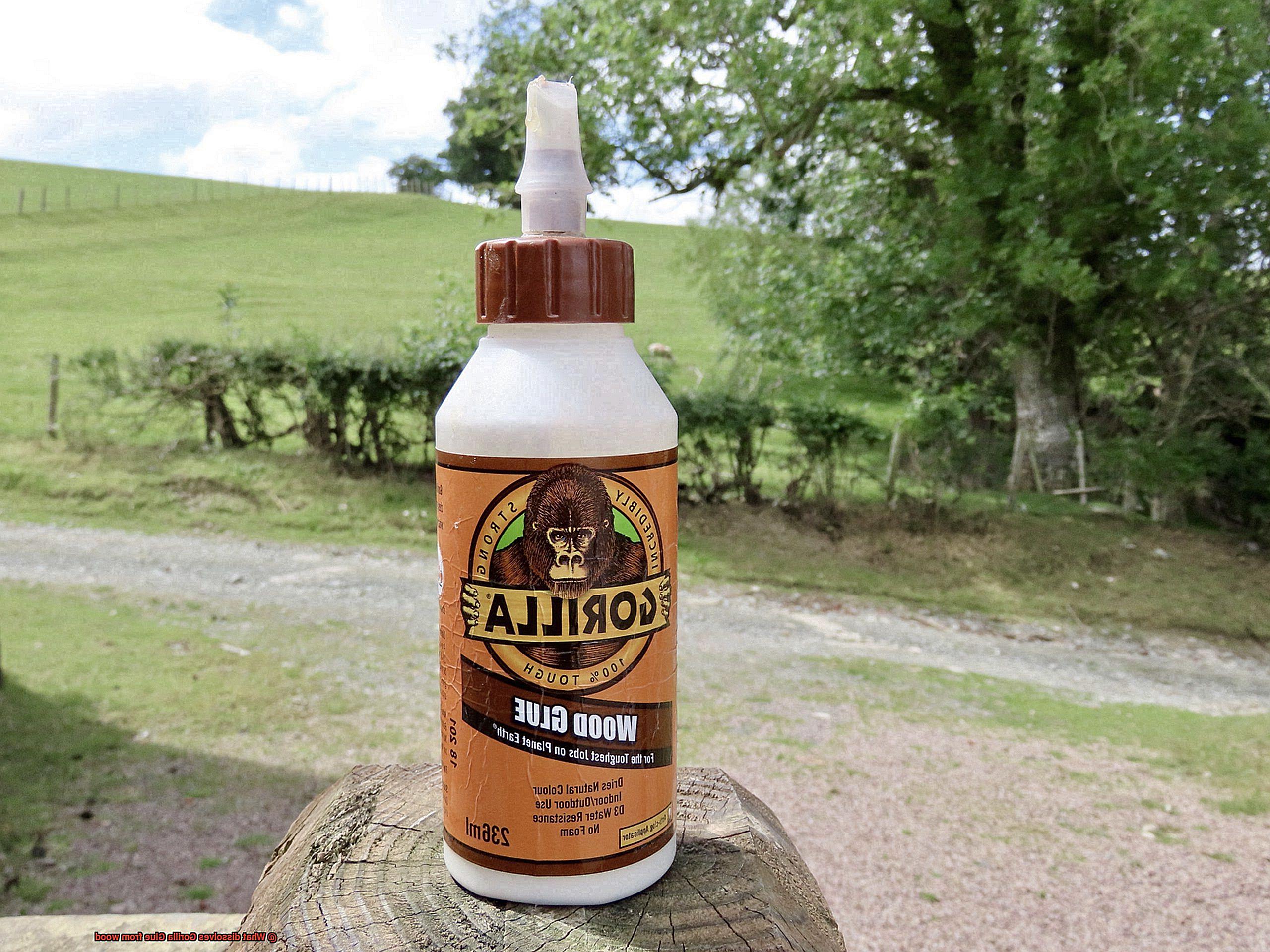
Acetone is a powerful solvent that can quickly and easily dissolve Gorilla Glue. It’s readily available at most hardware stores and is relatively inexpensive. However, caution must be exercised when using Acetone due to its highly flammable nature. Ingesting or inhaling large quantities of Acetone can also be harmful, making it unsuitable for households with children or pets.
Rubbing Alcohol is a popular alternative to Acetone as it emits fewer fumes and is less flammable. However, it may take longer to remove the glue from the wood and could leave a residue behind after use.
For those seeking a natural and safe alternative, Vinegar may be the way to go. It’s non-toxic and easily accessible in most households. When combined with heat and pressure, Vinegar can be effective in dissolving Gorilla Glue from wood. However, it may not be as potent as chemical solvents, especially on old or stubborn glue stains.
In summary, each solvent has its own set of advantages and disadvantages that should be considered before use. Acetone is effective but requires caution due to its flammability. Rubbing Alcohol is safer to use but may take longer to dissolve the glue. Vinegar is a natural alternative but may not be as strong as chemical solvents. Ultimately, the choice of solvent depends on personal preference and the specific needs of the project.
Tips for Removing Gorilla Glue from Wood
Removing Gorilla Glue from wood can be a tricky task, but with the right tips and methods, it can be done effectively. Here are some tips on how to remove Gorilla Glue from wood using acetone, heat, and scraping tools.
Acetone
Acetone is a potent solvent that can dissolve the adhesive and make it easier to remove. However, it can damage the wood surface, so use it with caution. It’s recommended to test a small area first before applying it to the entire surface. To use acetone, apply a small amount to a clean cloth and rub it onto the affected area. Let it sit for a few minutes before gently scraping off the glue.
Rubbing Alcohol
Rubbing alcohol is another solvent that can dissolve the glue and make it easier to remove. It’s less harsh than acetone and may be a better option for more delicate wood surfaces. Soak a clean cloth in rubbing alcohol and apply it to the affected area. Rub gently until the glue starts to soften and come off.
Vinegar
Vinegar is an acidic substance that can break down the glue’s bond and soften it. Mix equal parts of white vinegar and warm water in a bowl and apply it to the affected area with a clean cloth. Allow it to sit for a few minutes before gently rubbing the glue off.
Heat
Using heat is an effective method for removing Gorilla Glue from wood. A heat gun or hairdryer can be used to soften the glue and make it easier to remove. Apply heat to the affected area for several minutes until the glue softens. Once it has softened, use a scraper or sandpaper to gently remove the glue from the wood.
Scraping Tools
In some cases, using a scraper or sandpaper may also be necessary to remove Gorilla Glue completely. Use these tools with caution to avoid damaging the wood surface. Start by gently scraping off any excess glue, then use sandpaper to smooth out any remaining residue.
Alternatives to Solvents for Removing Gorilla Glue from Wood
Fear not, for we have got you covered. Removing Gorilla Glue from wood can be a challenging task, especially if you want to steer clear of harsh solvents that can potentially damage the surface of the wood. Luckily, there are alternative methods that are both gentle and effective on your wooden surfaces.
One such method is using heat. Since Gorilla Glue is activated by moisture, applying low heat to the affected area with a hair dryer or heat gun can break down the bond between the glue and the wood. This makes it much easier to remove without causing any harm to the surface of the wood. But be cautious not to overheat or scorch the wood, as this can cause more damage than good.
Another option is using mechanical means such as sanding or scraping. This method is particularly useful for removing dried or partially cured glue. Using a coarse-grit sandpaper or scraper, gently remove the glue from the surface of the wood. Be careful not to apply too much pressure that can cause damage.
If you’re dealing with hard-to-reach areas or stubborn glue spots, try using a microfiber cloth soaked in warm water. Placing the cloth over the affected area for a few minutes can activate the glue and make it easier to remove with a scraper or sandpaper.
If you’re still struggling to remove Gorilla Glue from your wooden surfaces, consider using a citrus-based cleaner or rubbing alcohol as a last resort. These options are less harsh than traditional solvents and can effectively break down the glue without causing any damage to your wooden surfaces.
QYmZSDjLQ9A” >
Conclusion
In conclusion, removing Gorilla Glue from wood may seem like a daunting task, but fear not. With the right techniques and tools, you can bid farewell to that stubborn adhesive without causing any harm to your wooden surface.
Solvents such as acetone, rubbing alcohol, or vinegar are effective in dissolving the glue and making it easier to remove. However, caution is key when dealing with these chemicals. Always wear protective gear and test a small area before applying any solvent to the entire surface.
Different types of wood may react differently to glue removal techniques. Therefore, it’s important to choose a method that suits your specific needs. Heat or mechanical means such as sanding or scraping can also be viable alternatives for removing Gorilla Glue from wood surfaces.


